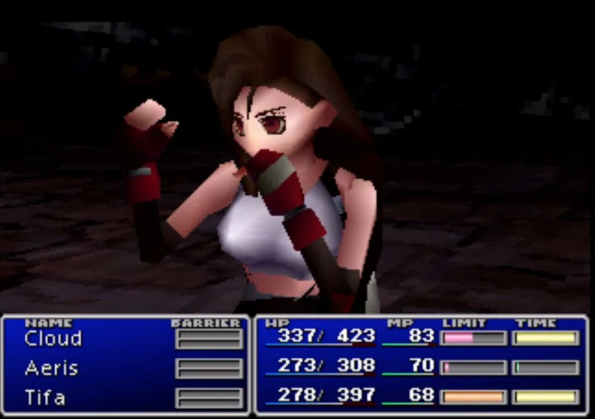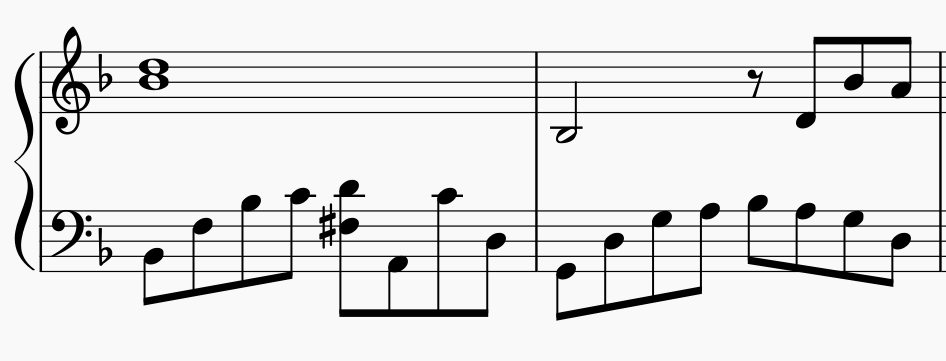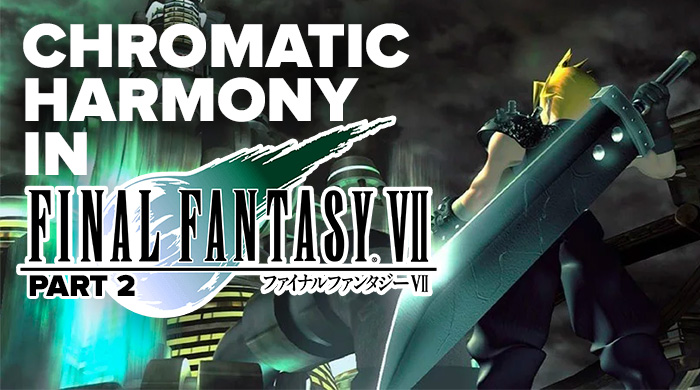Part Two: Tifa's Theme

This is Part 2 in our harmonic investigation of music from Final fantasy VII. If you haven’t checked out Part 1, click the link HERE. Continuing the trend, we shall be examining the theme music used for specific characters from the game, and seeing what we can learn. This week: Tifa’s theme.

In last week’s blog about Aerith’s Theme we saw how three different chromatic chords are used in the opening eight measures (chromatic chords are those that use notes outside of the key). In this piece, composer Nobuo Uematsu uses a lot more chromaticism throughout, and a greater variety of it too. So let’s examine the chords and see what we can learn, hopefully expanding our own harmonic vocabulary along the way (I like to flip-flop between metaphors: harmonic palette, harmonic vocabulary, composer toolbox etc.). Below you can check out the piano arrangement of the tune written for the film Advent children, which is the version we will be examining.
Tifa’s Theme is quite similar to Aerith’s Theme stylistically, structurally and tonally. Both seem to elicit a surprising amount of sadness, belying their major tonality. Also similarly to Aerith’s Theme, Tifa’s Theme begins with a tonic chord establishing the key (F major in this instance), immediately followed by a chromatic chord: in this instance, it is a diminished chord on the second position of the scale (also called the supertonic).

Before looking at that G diminished chord, let’s have a quick look at that opening F chord. Yet another harmonic similarity to Aerith’s Theme shows up here, as we can see that this opening chord is also an extended chord, rather than a simple triad. However, where Aerith’s Theme had the major ninth added to it in the high register, this has the major seventh of the chord, E natural, added in its low register making it a major seventh chord in third inversion. Like adding a ninth, this diatonic extension makes the chord richer and more colourful sounding, but the minor second clash between the E and F adds to the chord more unease and tension than the warm-sounding ninth.
Anyway, on to that G diminished! This is what you would actually call a half-diminished seventh chord, which is constructed by a diminished triad (a three-note chord with a minor third and a diminished fifth) with a minor seven added on top. To make it a full diminished seventh chord, that seventh would have to be double flattened, in this instance the F would become F flat (enharmonically an E natural).
A half-diminished seventh chord is what you get when building a chord on the second position of a minor key. So, like the chromatic chords we looked at in Aerith’s Theme, this is another chord which can be thought of as being borrowed from the parallel minor key. It sounds quite similar to the minor subdominant chord we looked at last week, so could be used as a substitute in certain cases for a little variety. To use the example from last week’s blog again, this half-diminished seventh chord on the supertonic position also turns up in Dream A Little Dream Of Me (not a particularly current example I’m aware, but still a nice tune).
Following this G half-diminished seventh chord, there are a few more bars of development taking us back through F major 7 again, until we reach this:

Here we have an E♭ dominant seventh chord with an added 2nd in the lower register. Just to make it clear, you often will get chords that are ‘suspended 2nds’, or simply ‘sus 2’ in jazz lead sheets and guitar chord charts. That would imply that the 3rd of the chord had been replaced with the 2nd, but that is not what this chord is, as the third of the chord is also there (the G natural in the high register). More commonly, dominant seventh chords like this will have the 2nd in a higher register, making them a 9th, so to say that this is an E♭9 would be functionally the same thing.
Now that we’ve cleared a few things up, let’s look at how this chord relates to the key in a little more detail. This dominant seventh chord is on the flattened seventh position of the key. This was mentioned in last week’s blog, as it commonly follows a major chord/dominant seventh chord on the flattened sixth position of the key. But as you can see from these examples, it is also common to find them in isolation. As with these other chromatic chords, this can be thought of as (you’ve guessed it) borrowed from the parallel minor key, as an E♭7 chord can be built diatonically in F minor, but not in F major. This E♭7 is very similar sounding to the G half-diminished 7, as it only differs in one note, using an E♭ instead of an F natural.
There’s actually so much chromatic development in this piece that to examine it all in detail could fill an entire thesis, and I’m not gonna do that here (hey it’s free content, you get what you pay for). There’s also something to be said for not bombarding people with too much information, as it can make it difficult to remember any of the specific details they have learned. I think an examination of three different chromatic chords in this piece will do just nicely to round us off, so let’s take a look at one more.
So after some more development, these opening chords take us to the main melody of the tune, which uses the chord progression of F major to G half-diminished seventh like in the opening phrase. Following this we come to this D dominant 7 chord:

The reason this dominant seventh chord on the sixth position works is because it acts as a perfect cadence hinting at a new key, in this instance G minor. Minor keys built from the second/supertonic position of the major scale only differ by one note, so are closely related: F major has one flat, G minor has two. The chord of G minor is also common to both keys, so a transition between them is very smooth. I say that the D 7 chord hints at the new key, because we don’t linger on G minor long enough or frequently enough for it to be established in the listener’s ear as the new key, we are merely passing through it.
So to sum up the three chromatic chords we have learned today: a half-diminished seventh chord on the second position of the scale, a dominant seventh chord on the flattened seventh position of the scale, and a dominant seventh chord on the sixth position, hinting at a new key. Exactly like I said in Part 1 of this blog series: Hopefully they are now part of your harmonic palette too, or ‘composer’s toolbox’ or however you like to think about it. Play around with them on your instrument of choice (or DAW), see how they sound and if you like them, what contexts in which they work or are appropriate etc. Maybe they’ll find their way in to your next compositions!
That’s all for today. In the third and final part of this blog series next week we will be examine the very different harmony in Vincent’s Theme (also called The Nightmare Begins).
See you then!
If you enjoyed this make sure you check out our other blogs, and stay tuned for more. If you’re serious about furthering your knowledge and your career in music, check out our Postgraduate and Premium courses on our website and see which ones are suitable for you. We’re always happy to help, so send us an email at contact@thinkspace.ac.uk with any questions and we’ll get back to you. Click the button below to take a look at our premium courses now.

